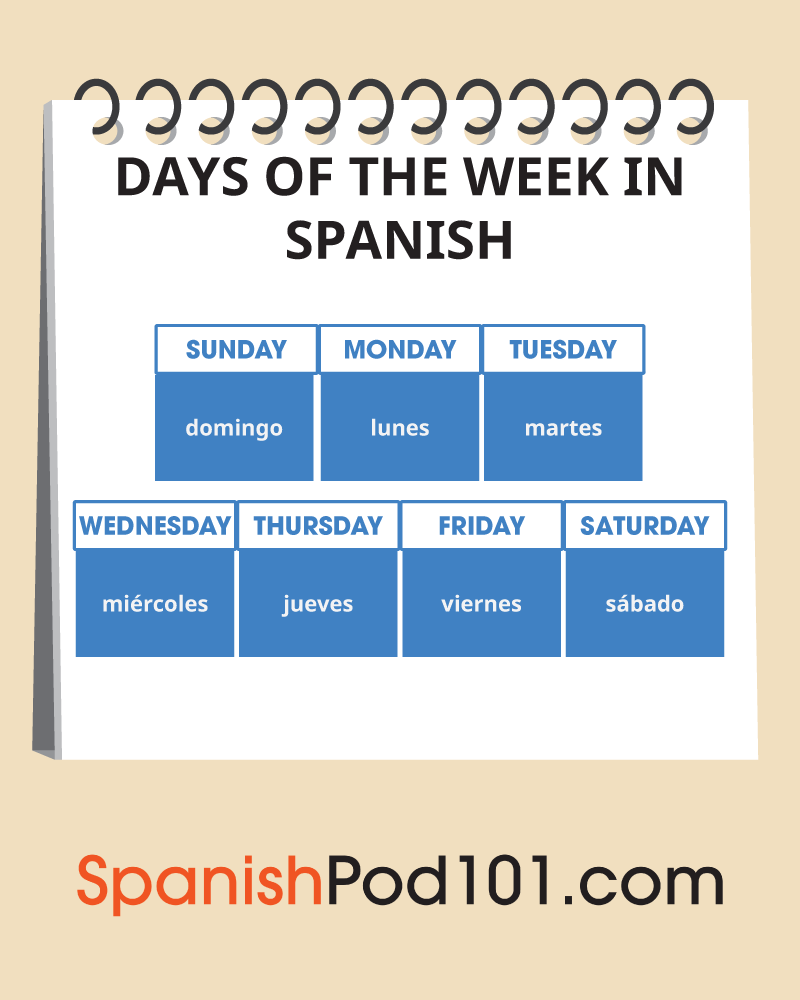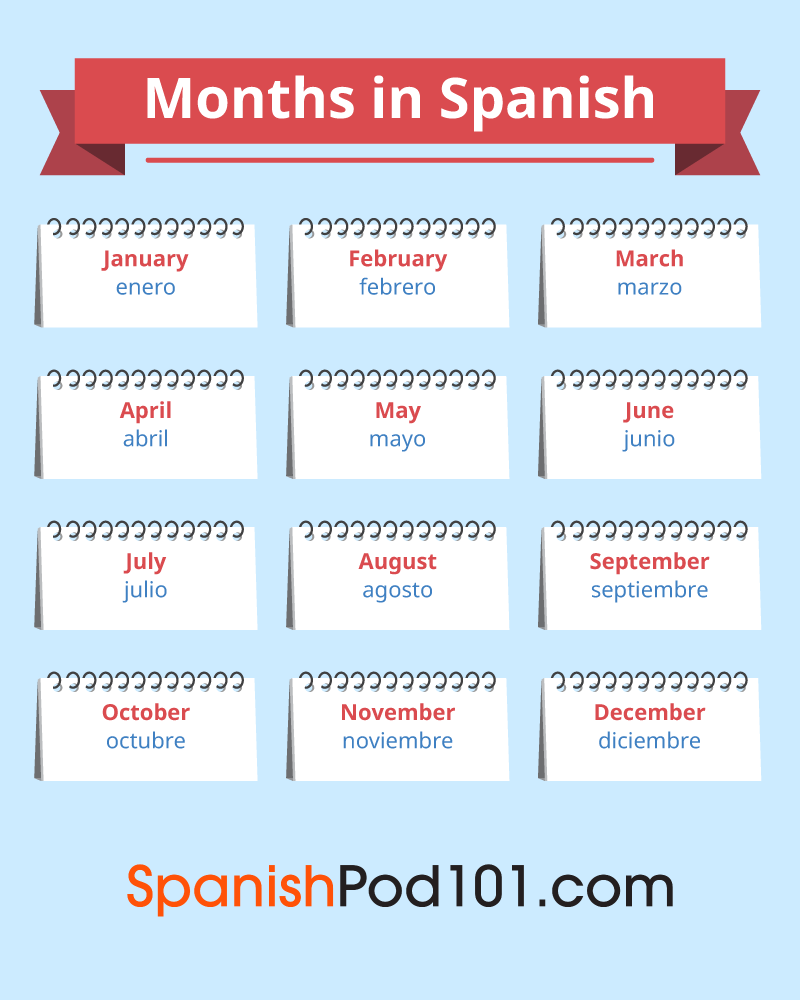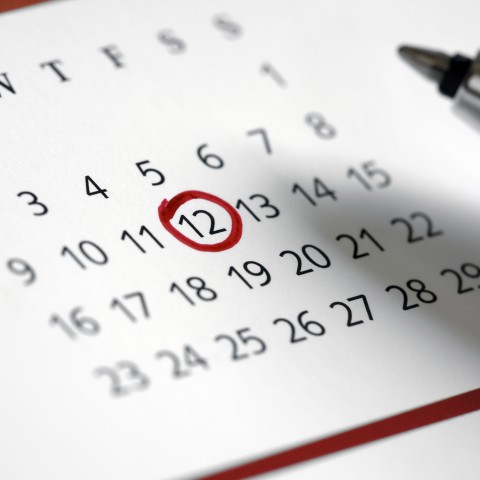Writing and saying dates in Spanish is a must when trying to improve your understanding of the language. In today’s world, you may want to write an email, book your next holiday to a Spanish-speaking destination, or set up a date. Or maybe you’re just having trouble reading dates in Spanish. No matter your reasons for learning Spanish, learning how to write dates in Spanish correctly could help you avoid some hassle.
It’s time to learn the dates in Spanish.
Maybe you think it’s enough to translate the numbers and the months…but let me tell you that expressing dates in Spanish is different than doing so in English ( U.K. English or U.S. English).
In this article, you’ll learn the rules for writing dates in Spanish, useful phrases for asking for and telling dates in Spanish, and much, much more about Spanish dates!
Let’s start with the basics.
Table of Contents
- Days of the Week in Spanish
- Days of the Month in Spanish
- Months in Spanish
- How to Say Dates in Spanish: Years
- How to Write the Date in Spanish
- Spanish Vocabulary for Setting Up a Date
- Must-Know Phrases to Talk about the Date in Spanish
- Using Prepositions When Learning Spanish Dates
- Spanish Expressions about Dates
- Conclusion: How SpanishPod101 Can Help You Master Spanish Dates
1. Days of the Week in Spanish
Before getting into writing dates in Spanish format and how to say calendar dates in Spanish, you need to learn the days of the week in Spanish. The first thing you need to know is that in Spanish, the week starts on Monday instead of Sunday. You may have noticed that in the Spanish calendar, the first day is an L, for lunes; this is “Monday.” Unlike some countries, Spain and many other European countries consider Sunday to be the last day of the week, rather than the first.
Sunday is the day of prayer, and the day to go to church. This is also why on most Sundays everything is closed in Spain. Today, in the modern world, things have changed, and Sundays are just a day off for people who work a nine-to-five schedule. Sundays continue to be a day off because of Catholic tradition.
What are the rest of the days of the week in Spanish?
- Lunes = “Monday”
Example:
Los lunes han empezado a ser mi día favorito de la semana.
“Mondays are now my favorite day of the week.”
- Martes = “Tuesday”
Example:
Los martes tengo ensayo con mi grupo de percusión.
“On Tuesdays, I have a rehearsal with my percussion group.”
- Miércoles = “Wednesday”
Example:
El día que más me cuesta seguir con mi entrenamiento es el miércoles.
“The day that I find most difficult to continue with my training is Wednesday.”
- Jueves = “Thursday”
Example:
Los jueves empiezo a trabajar a las 8 de la mañana.
“I start working at 8 a.m. on Thursdays.”
- Viernes = “Friday”
Example:
¡Por fin es viernes!
“Thank God it’s Friday!”
- Sábado = “Saturday”
Example:
Los sábados aprovecho para salir de fiesta con mis amigos.
“I go out on Saturdays with my friends.”
- Domingo = “Sunday”
Example:
El domingo es el día del Señor.
“Sunday is God’s day.”
The days of the week in Spanish are all masculine, so you say el lunes for “Monday.” Unlike in English, in Spanish, you don’t need to capitalize the days.
The first five days of the week in Spanish: lunes, martes, miércoles, jueves, and viernes are called días de la semana: “weekdays.” Sábado and domingo are the fines de semana: “the weekend.”
When learning the days in Spanish, you’ll also notice that in the Spanish calendar, the days of the week are written L M X J V S D. This is because martes, “Tuesday” and miércoles, “Wednesday,” start with M. To avoid confusion, miércoles will always appear as an X.
If you want a fun way to learn about them, you can also sing the days of the week in Spanish with a song!
2. Days of the Month in Spanish
In English, you must use ordinal numbers to say the date. But to say the days of the month in Spanish, you can use cardinal numbers. Uno de marzo: “First of March.”
In some Latin American countries, you may hear: Primero de mayo for “First of May.”
Here’s a list of the cardinal numbers you’ll need for months and dates in Spanish, from one to ten.
- Uno = “First“
- Dos = “Second“
- Tres = “Third“
- Cuatro = “Fourth“
- Cinco = “Fifth“
- Seis = “Sixth“
- Siete = “Seventh“
- Ocho = “Eighth“
- Nueve = “Ninth“
- Diez = “Tenth“
More examples:
Dos de mayo.
“Second of May.”
Note that while in English you must use “1st of May,” when giving dates in Spanish, you don’t need to use 1ero de mayo.
Example:
1 de mayo.
“1st of May.”
3. Months in Spanish
Learning the months of the year in Spanish can be easy because they’re almost the same as in English. Here are the names of the twelve months of the year in Spanish. It’s only Enero meaning “January” that doesn’t start with the same letter.
Another important thing to know when you’re learning the dates in Spanish is that when writing the date in Spanish, you don’t need to capitalize the month. Some may find this an informal way to write dates in Spanish, but it’s not. It’s acceptable.
- Enero = “January”
- Febrero = “February”
- Marzo = “March”
- Abril = “April”
- Mayo = “May”
- Junio = “June”
- Julio = “July”
- Agosto = “August”
- Septiembre = “September”
- Octubre = “October”
- Noviembre = “November”
- Diciembre = “December”
4. How to Say Dates in Spanish: Years
When pronouncing the years in Spanish, you can find one difference.
In English, you can say “twenty-nineteen” (2019) instead of “two-thousand nineteen.” In Spanish, you have to say dos mil diecinueve, instead of veinte diecinueve. This is one of the most common mistakes that English speakers make when learning how to write the date in Spanish. But once you get this down, learning dates in Spanish will be much simpler.
In Spanish, you can still find the use of Roman numerals when writing about centuries. As you may understand them in English, here’s a reminder of the Roman numerals from one to ten: I-II-III-IV-V-VI-VII-VIII-IX-X.
Examples:
- Esto es el Siglo XX.
“This is the 20th century.” - El carbón fue descubierto en el Siglo II.
“Carbon was discovered in the 2nd century.”
Another common form to use for an important date in Spanish is by using the acronyms “B.C. (before Christ),” which is a.C (antes de Cristo) in Spanish, and “A.C (after Christ)” or d.C (después de Cristo) in Spanish.
Example:
- El oro fue descubierto 6000 a.C.
“Gold was discovered in 6000 B.C.”
5. How to Write the Date in Spanish
Now, how are dates in Spanish written out?
When learning how to write the date in Spanish, here’s the formula of how to do it right. Once you know this formula, you’ll never do it wrong again.
El+[day of the week]+de+[month]+de+[year]
El 22 de junio de 2019
In Spanish is just the opposite of U.S. English; we use the DD/MM/YY format. A more formal way to say the date in Spanish is:
[day of the week], el [day of the month in number] de [month] de [year]
Sábado, 22 de junio de 2019
The examples above are the most common way to say the date in Spanish. However, if you want to write about the date in Spanish, there are many different ways you can do this. Also, keep in mind that writing the date varies among Spanish-speaking countries. In Spanish, these are the most popular ways:
1- Numeric
The formula for writing the date in Spanish is Day+Month+Year. However, you can divide the date in different ways:
You can divide them with dots: 12.03.2019; with slashes 12/03/2019; and with hyphens 12-03-2019. You can even omit the zero: 12/3/2019, although it’s more formal to keep the zero.
When writing the year in Spanish, you can also omit the first two numbers instead of writing out the whole of “2019.” You can just write 12/03/19, as long as the shortened year is the current year.
2- Words and Numbers
Writing the date in Spanish by mixing the numerals with words is very common, especially in setting future dates, since you may want the other person to remember the month. The formula is the same as the numerical one.
(number of the day)+de+(name of the month)+de+(numeral of the year)
22 de junio de 2019
Example:
- Nos vemos entonces el 23 de septiembre, 2019.
“We should see, then, on the 23rd of September, 2019.”
You can also write the whole date as veintidós de junio de dos mil diecinueve or “twenty-two of June of two-thousand and nineteen.” But this is less common.
6. Spanish Vocabulary for Setting Up a Date:
- Fecha = “Date”
- Hoy = “Today”
- Fin de semana = “Weekend”
- Ayer = “Yesterday”
- Próxima semana = “Next week”
- Anteayer o antes de ayer = “The day before yesterday”
- Mañana = “Tomorrow”
- Pasado mañana = “The day after tomorrow”
- Día = “Day”
- Semana = “Week”
- Día de la semana = “Weekday”
- Mes = “Month”
- Estación = “Season”
- Año = “Year”
- Año bisiesto = “Leap year”
- Siglo = “Century”
- Milenio = “Millennium”
- Década = “Decade”
7. Must-Know Phrases to Talk about the Date in Spanish
Time is constantly and consistently present in our lives. We live in a world where we arrange the time for everything. The time to work, the time to study, the time to exercise, and the time to travel. It’s also the number-one topic of conversation topic, because when you’re learning a new language, you’ll always try to set dates to meet others so that you can talk and improve your skills. If you’re trying to break the ice, here are some questions you may ask:
- ¿Cuándo empieza el verano?
“When does the summer start?” - ¿Cuándo empieza la escuela?
“When does your school start?” - ¿Cuándo es tu cumpleaños?
“When is your birthday?” - ¿Tienes planes para el 14 de febrero?
“Do you have any plans on the 14th of February?” - ¿Qué día es hoy?
“What day is it today?”
Note that the last phrase is only used as a reminder of the day of the week, because in Spanish it’s also used to ask the day of the month or the completion date.
You’ll also hear questions like: ¿A cuánto estamos hoy? meaning “How far are we today?” or ¿A qué día estamos hoy? meaning “What day are we on today?”
When someone asks the last question, it always refers to the day and also the current month: Hoy es veinticinco de enero meaning “Today is the 25th of January.”
8. Using Prepositions When Learning Spanish Dates
When writing and speaking about the date in Spanish, it’s essential to understand how to use the prepositions correctly. In English, you use “on” when referring to something that happened (or will happen) on a specific date: “The meeting was on Tuesday.” In Spanish, you can use el: La reunión fue el martes. “On” can be translated as en, but you need to learn how to use it appropriately.
Example:
- Estamos en marzo
“It’s March.”
Example:
- Te veo el sabado
“I will see you on Saturday.”
The prepositions desde-hasta and de-al are normally used to talk about date intervals. Unlike in English, where you just need to use “from” or “to.”
Example:
- El verano es desde junio hasta septiembre.
“Summer is from June until September.”
Example:
- Estaré de vacaciones del 2 al 20 de agosto.
“I will be on vacation from 2nd to 20th August.”
The use of the preposition del in Spanish is the union of de + el= del.
Example:
- Hoy es 14 de abril del 2019.
“Today is the 14th of April of 2019.”
Another important preposition to learn is durante. Durante means “during” and “throughout.” In Spanish, you can use durante whenever you want to talk about a date occurring during a certain timeframe.
Examples:
- La globalización habrá empezado durante el siglo XIX.
“Globalization may have started during the 19th century.” - Sarah ha estado en forma durante toda su vida.
“Sarah was very fit throughout her life.”
9. Spanish Expressions about Dates
Understanding an expression when learning a new language is the best way to know if you’re improving. Keep these Spanish expressions in mind. Make jokes while learning and leveling up!
- Gracias al mundial de fútbol, los hoteles están haciendo su agosto.
“Thanks to the FIFA World Cup, hotels are having a field day.”
This expression means that August is one of the most touristic months. In Spain, this is when everyone takes holidays, so the tourist companies are having a field day.
- Siempre estás en medio como los jueves.
“You’re always in between like Thursdays!”
This expression may not need any explanation. But basically, Thursdays are in the middle of the week (no one likes the middle of the week!), so when someone’s disturbing you, you can tell them this.
- En abril aguas mil.
“In April it rains a lot.”
This expression is about the weather. April is a rainy month in Spain.
- Cuando en marzo mayea, en mayo marcea.
“If in March mayea, in May marcea.”
This expression is also about the weather. It means that if March is like the weather in May, May will be like the weather in March.
- Como agua de mayo.
“Like May’s water.”
This expression comes from the life in the countryside. April and May are rainy months which are perfect for the plantations. The rain allows the fruit trees to bloom in their greatest splendor. So, if someone says Como agua de mayo, it means that something has come perfectly and at the right time.
Example:
- La paga extra de verano me viene como agua de mayo!
“The summer extra pay comes like May’s water!”
10. Conclusion: How SpanishPod101 Can Help You Master Spanish Dates
So next time you’re planning a trip with your fellow Spanish friends, you can be certain that your date matches theirs. This way, you can enjoy planning events, holidays, and days out, while also ensuring that you’ll be there at the right time.
What did you find most useful in this article? What are you still struggling with? Let us know in the comments! Remember that when it comes to dates in Spanish, practice is essential. Why not leave us a comment with today’s date in Spanish too? 🙂
You can also download our dates vocabulary sheet for free and have it on hand for any questions you may have.
SpanishPod101 has many free vocabulary lists about the Spanish days of the week, months in Spanish, and how to write the date in Spanish. Get cracking!
With enough studying, practice, and determination, you’ll be speaking Spanish like a native! And SpanishPod101 will be here for every step of your language-learning journey.


















